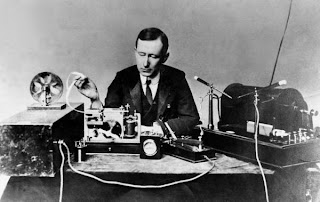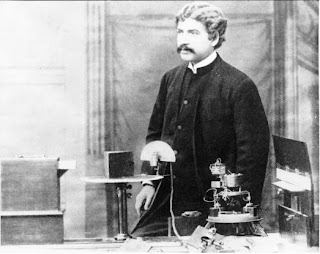History of the Radio
Part One
 |
| Marconi Radio Receiver |
There has always been some debate about who the inventor of the radio is. Therefore, it might be best to say that several people were responsible for the invention of the radio that we know and love today. Radio was first developed for a means of communication between two people who are in different places. An effective means of communication between people at different locations has been sought after since the beginning of civilization.
When Benjamin Franklin discovered that there were negative and positive charges in electricity, the search to use electricity as means for communication was started. Radio signals were sent through the many cables of the telephone network and were used mainly for the military.
 |
| Heinrich Hertz |
.jpg) |
| Nikola Tesla |
During the 1860's, radio waves were shown to exist by James Clerk Maxwell, who was a Scottish physicist. In 1876, Alexander Graham Bell sent a message using an electromagnetic signal. In 1886, Heinrich Hertz showed that radio waves could be transmitted and received. He had no idea that this would be a very important building block for the development of the radio.
Nikola Tesla was the inventor of the model for radio, but only in theory. However, Tesla's invention of transformers and the Tesla coil helped in the production of radios. These were some of the core components used in radios.
 |
| Guglielmo Marconi 1901 |
Guglielmo Marconi was a physicist from Italy and in 1896, he sent coded signals about a mile. He instantly saw the potential for this type of communication and tried to give this invention to the government of Italy but they weren't interested. He decided to move to England and continued to experiment with this wireless technology and to patent his invention. In 1898, he broadcast the winners of the Kingstown Regatta to a Dublin newspaper. This was the first public sporting broadcast. Marconi built a radio factory and joined Britain And France with a telegraphic link. In 1901, the United States was linked by telegraph radio to Britain.
 |
| J.C. Bose |
In 1896, a scientist from India, J.C. Bose, showed the British Governor General that a radio transmission could be sent over three miles away. In 1899, Bose once again demonstrated this for the Royal Society in London. While at this event, his notebook that included a drawing illustrating a
Mercuri Cohere with a telephone detector, was stolen. Marconi happened to be at this event and when Marconi developed his own Coherer, it was an exact copy of Bose's.
Bose did apply for a patent as the inventor of the radio, in 1901 and was awarded it in 1904. However, Marconi by this time had already received the recognition and patent for being the inventor of the radio.
The first wireless transmission of voice, however, was not made until 1895, when Russian, Aleksander Poppov sent a secret message to a ship on the ocean. This was kept secret and the Russian government only recently has given Poppov this credit.
 |
| Reginald Fessenden |
In 1904, Ernst Alexanderson was the first to make an alternator that made it possible to transmit speech, instead of dots and dashes. Reginald Fessenden is usually credited with the first voice transmission that was made in 1906, when he used Alexanderson's alternator. This alternator enabled him to make the first long range transmission of something other than dots and dashes. Ships out at sea could hear Fessenden playing the violin and reading a Bible verse.
 |
| Lee De Forest |
 |
| The Audion Triode Vacuum Tube |
In the early 1900's, this technology was used mostly as a radio telegraphy system using Morse Code. In 1907, an American inventor by the name of Lee De Forest patented the electronic device, the Audion, which was a vacuum tube that amplified radio waves. This vacuum tube enabled music, voice or other broadcast signal to be heard clearly. These tubes detected different frequencies so that different channels could be detected and used.
In 1912, the American airwaves became regulated by the Federal government. All ships had to include a radio and a trained operator. Any amateur radio operators needed to be licensed. As other inventors and businessmen were beginning to see the potential for these amplified radio waves, World War I broke out and the government took over all radio broadcasts and closed down any other radio stations that were not needed.


.jpg)




